WILLIAM HENRY GREEN
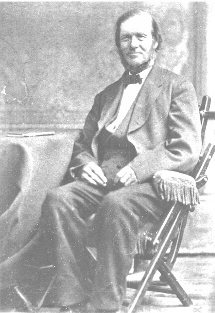
William Henry Green

Baptism record for William Green in Penn:
"William son of John and Sarah Green, Feb 5".
William's parents had an older son, John, who had died before
William was born. No other children for John and Sarah have been
found. At some point, the Green family moved back to the parish
of Claverley,
Shropshire, where John and Sarah had been married.
William's mother, Sarah, died in April of 1830 in Claverley.
Later that year, William married Mary Bennett Thomason in on 20
July 1830 in Kingswinford, Staffordshire. A few weeks later,
William's father, John, died in Claverley in August of 1830.
The parish register for Kingswinford shows:
William Green, of this parish, and Mary Thomason, of this parish, were married in this church by banns, with consent of ________ this twentieth day of July in the year one thousand eight hundred and thirty, by me, Edward Davies, Curate.
William Green, his mark
Mary Thomason
In the presence of: Ann Embry
William
Bennett, his mark
Source: Kingswinford parish register, FHL# 435779
Mary was twelve years older than William at the time of her
marriage, and had an seven-year-old daughter, Sarah. William was
21 years old when he married the 33 year-old Mary. They settled
in the townland of Farmcott, in the parish of Claverley,
Shropshire.
The Henson Walker Genealogy states: “Although several years
his senior, Mary proved to be a very capable and efficient
helpmate. A small cottage of rough lumber located in the
market town of Claverley, in the All Saints parish, was the
first abode shared by William and Mary. William, a common
laborer, earned his daily bread by the sweat of his brow.
Mary, young and industrious, added comfort and refinement to
their home and surrounding. In times of scarcity, even though
William worked fourteen hours a day as a farm laborer, his
income was small.”
A son, Samuel, was born to them in 1831. Another boy, John, was
born three years later, in 1834. A daughter, Mary, was born in
1838, followed by another girl, Hannah, in 1841. William's
occupation is listed on his daughters' birth certificates as an
agricultural labourer.
The family is found in the 1841 English census in the townland of Farmcott, in the parish of Claverley:
Name
Age
Occupation
Born
in this county?
William
Green
30
Ag.
Lab.
Y
Mary
" 40
Y
Samuel
" 9
Y
John
" 6
Y
Mary
" 3
Y
Hannah
"
2
months
Y
Edward
Bennett
40
Ag.
Lab.
Y
Eliza
" 7
Y
Source: 1841 census, Claverly, FHL# 474583
It appears that Mary's brother, Edward is living with the Green
family, along with his daughter, Eliza. Both Edward and William
were agricultural laborers on the farm of Vincent Edwards, a
yeoman farmer of Farmcott. The listing under Mr. Edwards' farm
includes six agricultural laborers, one male servant, and two
female servants. Altogether, six families are included under the
Edward's farm, for a total of 26 people. The townland of
Farmcott includes 191 people.
As the Green children grew they went to work to help support
the family. At the age of five, daughter Mary attended the
village school three months out of the year, and learned to read
and write. At the age of nine, she worked three days a week, for
12-hour shifts at a cotton mill five miles away. Samuel and John
found work in Gloucestershire and Staffordshire.
The greatest change in the family came in about 1849. The
family came in contact with missionaries of the Church of Jesus
Christ of Latter Day Saints, and were baptized. Later, Samuel
and John were baptized, 5 November 1851. Hannah's baptism date
is unknown. (Some family records place the Green family in
the Studham or Kensworth branches in Hertfordshire. However,
they are not found in the LDS branch records for that time,
and these locations are a considerable distance from the other
known homes of the Greens. There is a William Green in the
branch, but he is recorded as being married to Susannah Hews
Green. They had a young daughter, Amy. This family is shown as
moving to Watford in November, 1853. There is also a Mary
Green in the records, but she is not married. Source:
LDS Record of Members, 1837-1858, Bedfordshire Conference,
FHL# 086979. Also, the Green family is found still in
Claverley parish in the 1851 census.)
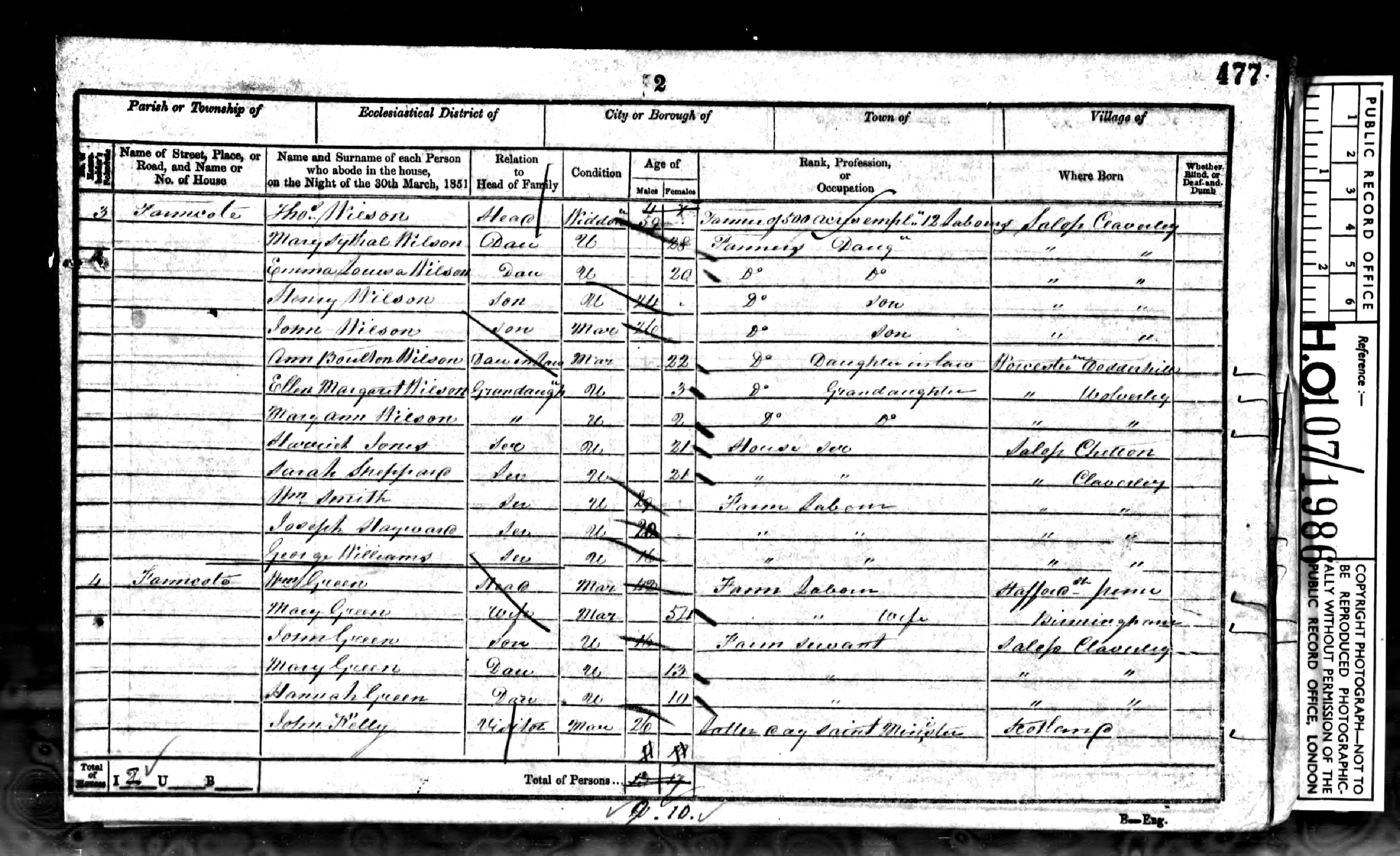
1851 census,
Claverley, Shropshire, England
The Green family appears in the English census in Farmcote, Claverley parish in 1851, and an LDS missionary was staying with the family:
Wm Green, head, married, 42, Farm laborer, born
Staffordshire, Penn
Mary Green, wife, married, 54, Farm laborer wife, born
Birmingham
John Green, son, unmarried, 16, Farm servant, born Salop,
Claverley
Mary Green, daughter, unmarried, 13, ", "
Hannah Green, daughter, unmarried, 10, ", "
John Kelly, visitor, married, 26, Latter Day Saint Minister,
born Scotland
Perhaps this is the missionary who baptized family members.
The family saved their money to come to Zion. In December of
1852 they left their little grey stone cottage on McRowan Street
in Worcestershire to travel to Liverpool. “Arriving at
Liverpool, William deposited six thousand shillings to pay for
their transportation to America. After making all
arrangements, they were told the sea was rough and dangerous
and that no ships would sail until the middle of January,
which was more than two weeks away. The only thing William
could do was rent a small place and wait.” (Henson
Walker Genealogy)
The family was assigned to the Ellen Maria, but at the
last moment the captain told them that only Samuel could go. He
sold his ticket, and waited with the family. They prepared to
sail on the Golconda, but were transferred to the Elvira
Owen. They finally set sail on 15 February 1853. 345
Saints traveled under the leadership of Joseph W. Young.
Excerpts from the journal of the Elvira Owen show:
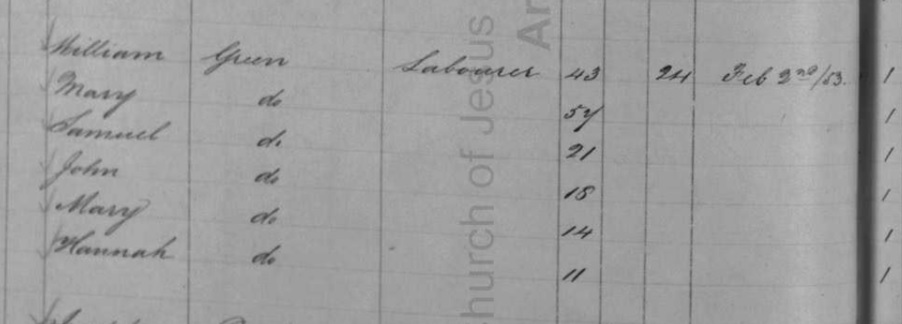
Elvira Owen ship's passenger list for the Green family
William Henry Green age 43 laborer
The address of the William Henry
Green family as recorded on the ship's register was: M. Rowan,
Worcester, Worcestershire, England. "On Tuesday, February 15,
1853, under direction of Joseph W. Young, who presided over
the Preston Conference, a company of 345 Saints, namely 261
adults, seven cabin passengers, and four cooks, sailed from
Liverpool, England on board the ship "Elvira Owen",
the sixty-fourth company of Saints." (Journal of
the Elvira Owen)
The Millennial Star records: "Under
the direction of Joseph W. Young, who had presided over the
Preston Conference, a company of three hundred and forty-five
Saints sailed from Liverpool on the fifteenth of February,
1853, on board the ship Elvira Owen...On the twenty-third of
March, 1853, after a most speedy voyage lasting only
thirty-six days, the Elvira Owen arrived at the bar at the
mouth of the Mississippi River. Three births, three marriages
and three deaths occurred during the voyage. There were a few
cases of small-pox, which, however, did not prove fatal, and
the disease did not spread to any great extent. Captain Owen
treated the Saints with much kindness, especially the sick,
and a memorial, expressive of their gratitude for his fatherly
conduct to all, was presented to him by the passengers. After
being detained at the bar several days the Elvira Owen was
towed up the river, and the emigrants landed in New Orleans on
the thirty-first of March. Proceeding up the Mississippi River
the emigrants arrived in Keokuk on the thirteenth of April,
being two days short of two months from Liverpool, which was
considered an extraordinarily rapid journey." (Millenial
Star,
Vol. XV, pp. 154, 288 and 361, on the Mormon Immigration Index
CD)
"On
March
23, 1853 after a speedy voyage, lasting only 36 days, the ship
arrived at the bar at the mouth of the Mississippi. The trip
across the vast span of water was far from being pleasant. The
Green family, along with others, were frightened and seasick
from the rocking of the ship and the violent waves dashing
over the deck. Food and fresh water must be taken along. One
pint of drinking water a day was allowed each person. All
cooking was done in a small room on deck, then the food had to
be carried down the ship ladder to the family members below."
(History of William Henry Green; Melissa Green Manwill)
The Green's youngest daughter, Hannah, remembered that "as
they crossed the ocean the waves would rock the ship and how
seasick some would get." (The Family of William
Henry Green; Joseph B. Robinson)
The ship arrived 13 April 1853.
"Waiting to welcome the Saints at the bar was Brother John
Brown, the Church agent in charge of all Saints on their way
to Utah. After being detained for several days, the vessel was
towed up the River, landing in New Orleans the 31st day of
March. Proceeding up the river they arrived at Keokuk on April
13, being two days short of being two months since leaving
Liverpool. This was considered an extraordinarily rapid
journey." (History of William Henry Green; Melissa
Green Manwill)
Keokuk,
Iowa
was the main outfitting point for the Saints. "While making
necessary preparations for the long trek across the Plains,
the Green family pitched their tents at Montrose, Iowa." (History
of William Henry Green; Melissa Green Manwill)
Montrose was just across the river from the beautiful and nearly
deserted city of Nauvoo.
The
family
prepared to make the 1500-mile journey to the Salt Lake Valley.
The Green family travelled with the Cyrus H. Wheelock Company,
and was in the James Picton Ten Pound Company. The company left
Keokuk on 3 June 1853.
"The James Picton Ten Pound
Company, Members of the Joseph Davis Hundred:
William Henry Green
A study of the passenger list
of the ship Elvira Owen and that of the Cyrus
H. Wheelock Company indicates that the 345 Saints who left
Liverpool, England, February 12, 1853, stayed together as a
whole and made up the bulk of the 396 members of the Cyrus H.
Wheelock Company. The William Henry Green family was one
of those who made the continuous journey, although the name of
Samuel Green is not included in the Cyrus H. Wheelock Company
passenger list. It is not known how Samuel Green reached the
Great Salt Lake Valley. There is some evidence, however, that
he did arrive with his family." (History of the
William Henry Green Family, 1970)
William was 44 years old, and
Mary was 57 years old. A history of John Green talks about the
challenges Mary faced: “They had to walk the whole distance
as there weren’t enough wagons and oxen for them to ride.
Their mother (Mary Bennett Green) was a very
frail little lady and the trip was very hard on her. Her two
sons, Samuel and John would put her on a cart and push her
part of the way.” (Life of John Green) The
youngest daughter, Hannah, was only eleven years old, and
remembered, "She told about the trip across the plains, how
most of the people had to walk and how tired she would get
being so small. She said many times she got under some of the
bedding where she could not be seen, then she could ride. Food
was very scarce, and there was sickness. It was a long weary
road with many discouraging days for the company." (The
Family of William Henry Green; Joseph B. Robinson) They
arrived in the Salt Lake Valley on 16 October 1853. After a
short rest, they traveled south to Pleasant Grove in their
covered wagon.
In Pleasant Grove, the fort had
just been completed. The Green family lived in their covered
wagon, until a one room house could be built inside the fort
square. This was a large one-room log cabin. A map of early
Pleasant Grove showed the William Green family in Lot 1 on South
Street. Opposite them, in Lot 1 on North Street, is a lot
labeled “Bennett”. It is not known if this was a relation
of Mary’s.
1855 was a difficult year for
the Saints in Pleasant Grove. Crickets destroyed the crops. Mary
and her daughters gathered sego, thistle and red roots to feed
the family. William moved his family to a two-story soft rock
home he built. (It is still standing, at 309 South 100 East in
Pleasant Grove, and stayed in the Green family until
1975.) In a history of Hannah Green, she remembered that "after
the family settled in Pleasant Grove, her older sister helped
their mother in the house and the two older boys and she
worked on the large farm with their father". (Quoted in
the History of the William Henry Green Family, on file
with the Daughters of Utah Pioneers)
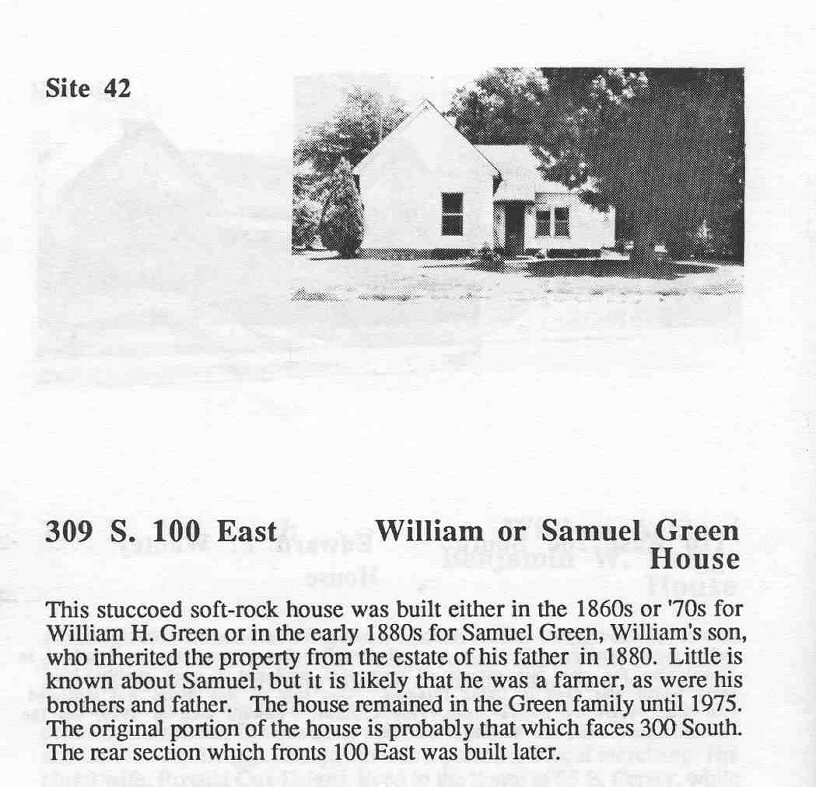
Walking Tour of Pleasant Grove
William and Mary’s children
married and set up homes of their own. Mary married Bishop
Henson Walker in 1856. John married Sarah Alexander the same
year. Samuel married Pamelo Wishaw in 1858. Hannah married
George Meyrick in 1862. The 1860 census shows John, Samuel
and William all living next to each other.
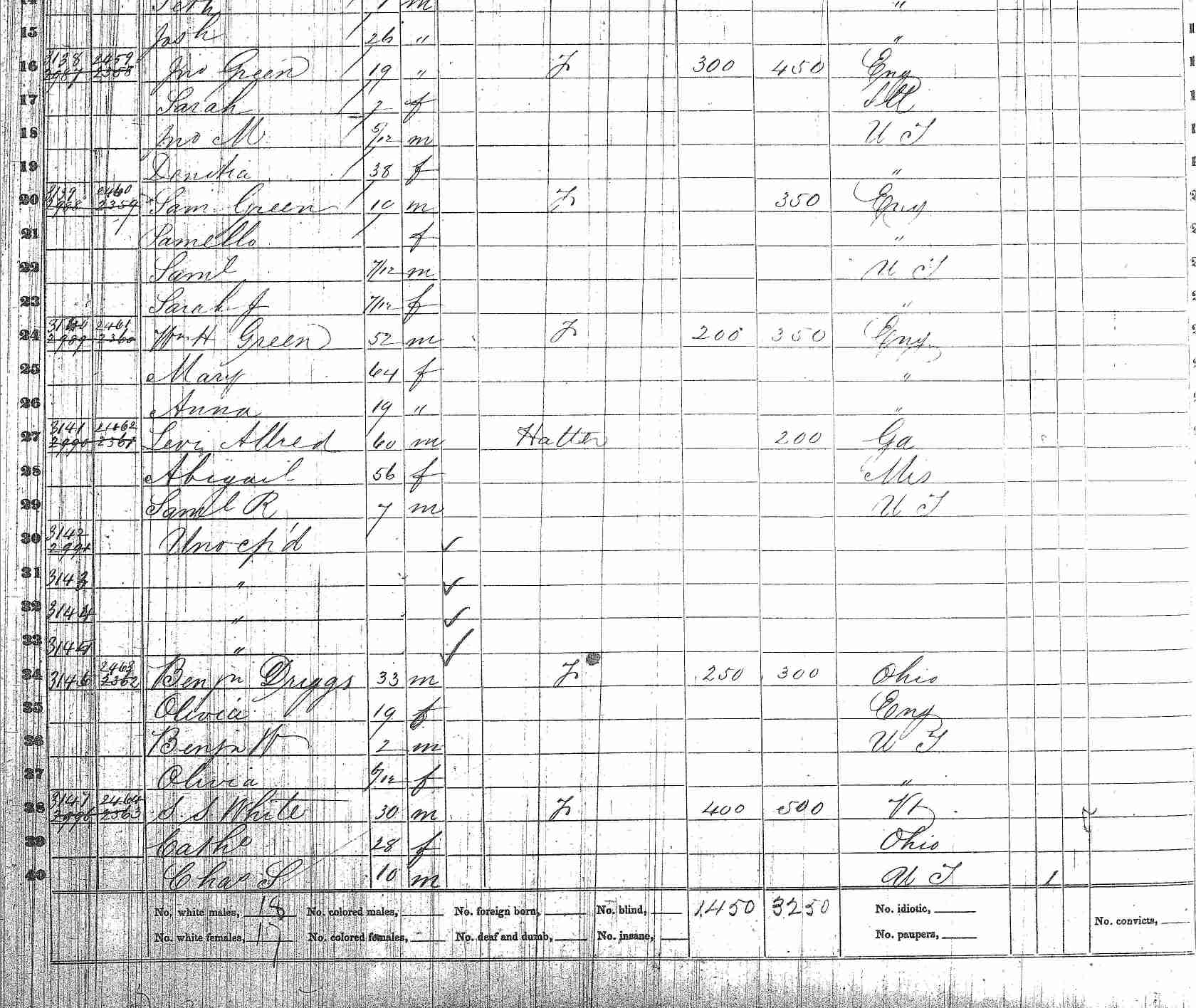
As
the settlement of Pleasant Grove grew, William became the town
herdsman. He was responsible for taking the cattle safely to and
from pasture each morning and night. There were marauding
Indians and would steal a calf or cow when they could. In
the History of William Henry Green it states "The
Green family was industrious and became progressive farmers.
They were extremely prompt and exact in every detail. An old
friend of the family often told how as neighbors they could
safely set their clock by William Henry Green taking his cows
to the pasture." Another history says: "William
was a strong believer in the old saying, "Make hay while the
sun shines", for in the spring he was up at 5 a.m. In the
winter, six o'clock found him up working around his home."
(History of William Henry Green; Melissa Green Manwill)
William must have been asked to
care for additional plural wives. Records show a marriage to
Mary Ann Simmons Harris 1 October 1864 in Salt Lake City,
and Ellen Edmondson Kendall in 1866 in Salt Lake City.
Ellen appears on the 1870 census with William and Mary.
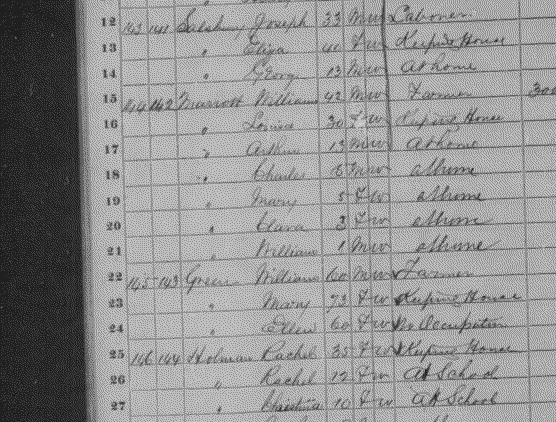
1870 census, Pleasant Grove, Utah
Ellen Kendall Green died in
1872. Mary Bennett Green died on 9 July 1974, aged 78, and was
buried in the Pleasant Grove Cemetery. William married
Joanna Richards Hicks 9 November 1874 in Salt Lake City.
"William
Henry
was of a very jovial nature. He was of a medium build, with
thin dark hair. He had a capacity for courageous faith. It is
to the credit of the Green family that they met the test. He
was a stalwart colonizer in the Pleasant Grove settlement. He
helped the town grow toward a better life for its people. He
had a span of mules, and one night he went into them without
first talking to them. They became frightened and kicked him.
He died from the effects of this accident." History
of William Henry Green; Melissa Green Manwill)
William Henry died December 5, 1878, at the age of seventy, and
was buried in the Pleasant Grove Cemetery.
William left a will probated 27 January 1879:
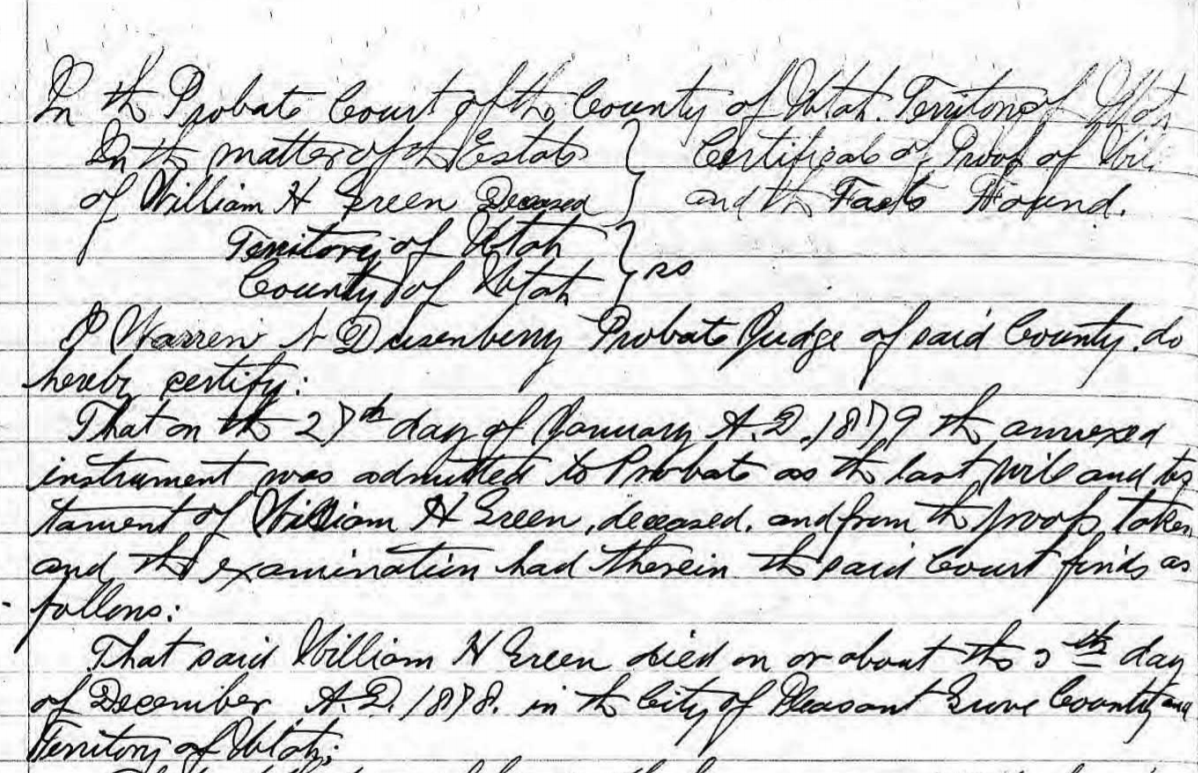
Will of William Henry Green
In
the Probate Court of the County of Utah Territory of Utah
In the matter of the Estate of William H Green deceased,
Territory of Utah, County of Utah
I Warren A Dusenberry Probate Judge of said County do
hereby certify:
That on the 27th day of January A.D. 1879 the annexed
instrument was admitted to Probate as the last will and
testament of William H Green, deceased, and from the proof
taken and the examination had therein the said court finds as
follows:
That said William H. Green died on or about the 5th day
of December A.D. 1878 in the City of Pleasant Grove County and
Territory of Utah:
That at the time of his death he was a resident of said
Utah County, Territory of Utah:
That the said annexed will was duly executed by the said
deceased in his lifetime in the City of Pleasant Grove, County
and Territory aforesaid and signed by the said testator
in the presence of Henry Greenhalgh, James Armistead, &
William Marrott the subscribing witnesses hereto: also that he
acknowledged the execution of the same in their presence and
declared the same to be his last will and testament, and the
said witnesses attested the same at his request in his
presence and in the presence of each other.
That the said deceased at the time of executing said will
was of the age of eighteen years and upwards, was of sound and
disposing mind and not acting under restraint, undue influence
or fraudulent misrepresentation nor in any respect incompetent
to devise and bequeath his estate.
In witness whereof I have signed this certificate and
caused the same to be attested by the Clerk of said Court,
under the seal thereof this 27th day of January A.D. 1879
Warren A Dusenberry, Probate Judge
Wiliam H. Dusenberry Probate Clerk
Last Wall and Testament of Wm H Green deceased
In the name of God Amen know all men by these presents,
that I William H. Green of Pleasant Grove City in the
County of Utah and Territory of Utah being in ill health, but
of sound and disposing mind and memory, do make, ordain and
publish this my last will and testament, hereby revoking all
former wills by me at any time heretofore made.
And as to my wordly estate, and all the property, real,
personal, and mixed, of which I shall die seized and possessed
or to which I shall be entitled at the time of my decease I
devise bequeath, and dispose thereof in manner following, to
wit:
First my will is that all my just debts and funeral
expenses and other expenses necessarily incurred in the
execution of this my will and testament shall by my executors
herein after named be paid out of my estate as soon after my
decease as shall by them be found convenient.
Items, I give, devise and bequeath to my beloved wife
Johanna Hicks Green as following, namely: Lot two in
Block six area three acres be the same more or less. Also, the
west part of lot one in Block five area 44/160 acres; situate
and being in Pleasant Grove City survey of building lots: with
the dwelling house thereon household furniture effects wares,
and appurtenances thereunto belonging, with the Granary &
barn, out houses, stables, canals, fences, and fencing
materials, firewood, and all other improvements belonging to
or in any manner pertaining to said lots. (Also fifty bushels
of wheat and a suffient amount of potatoes, carrots, and other
vegetables for table use for one year) also two cows to be by
her selected from those now on the premises with hay and
fodder necessary to keep them one year, also two hogs, and all
the poultry on the place. Also six 3/160 acres of meadow,
located and described as follows: commencing 1025 chains south
from the northeast corner of Sec. 31.T.e S. of R.2.E, then
running west by south 91 chs then South 6.40 chs then East
9.25 chs, then South 6.70 chs to place of beginning.
(Also the following portion of my farm and pasture (the
situation of said farm and pasture will be described more
fully in my bequest to my son John Green) The portion
here bequeathed to my said wife commences 5.60 chs. South from
the N.E. corner of said farm, then running south 5.08 chs to
old fence line then along said line 620 chs to R.R. then along
the E. line of said R.R. 5.72, then E 6.88 chs. to place of
beginning.
Also two of my shares of the capital stock of the
President Directors and Company of the Pleasant Grove Co. of
The Institution which are of the fair value of $50.00.
Also, all my stock of the President, Directors and
Company of the Utah County Stock Associations which is of the
fair value of $22.00. Also, all my personal property not
otherwise herein bequeathed be the same in money, gold,
silver, note or debts due my estate I give to my said wife:
and hereby order that she my beloved wife shall out of this
portion or money pay or cause to be paid all the expenses of
my funeral when orders issued by such executors herein after
names (I would here mention that there is now due my but for
which I have no notes $35.00 from Mrs Bates of American Fork
City and the same amount from F. Beers of Pleasant Grove City
with the interest thereof).
The real estate and the improvements thereon with the
income rents issues and benefits thereof herein bequeathed to
my said beloved wife Joanna Hick Green shall be for her use
for and during the term of her natural life. And the rights
reversion and remainder of said real estate and improvements
here bequeathed to my said wife Joanna Hicks Green shall at
the decease of my said beloved wife go to my son Samuel
Green now living in Pleasant Grove City aforesaid.
I give and bequeath to my son Samuel Green 8
154/160 ac of meadow land located and described as follows,
viz: commencing 1025 chs south and 1380 chs East by North from
the north west corner of Sec 31; Township 5 acres of Range 2
East then running South 1020 then East by south 8.30 chs then
North 10.35 chs then west by south 8.30 chs to the place of
beginning all in the Northwest quarter of Sec 32 Township
Souths of Range 2 East. Also the rights, titles, interest,
reversion and remainder of the real estate and the
improvements theron, herein described and bequeathed to my
beloved wife Joanna Hicks Green from and after the death of my
said wife: to have and to hold the same unto my said son
Samuel Green and to his heirs forever.
Also two of my shares of the capital stock of the
President, Directors and Company of the Pleasant Grove Co. of
the Institution which are of the fair value of $50.00, also my
old wagon I give, devise and bequeath to my son John Green
now living at Mona Juab Co. & the lands described as
follows, viz commencing 10.25 chs south from the north west
corner of Sec 32 Township 5 south of Range 2 East then running
south 6.15 chs then East 7.50 chs then North 7.20: then west
by south 7.53 chs to the place of beginning area 5 40/160
acres; also my farm and pasture, less the portion herein
before bequeathed to my beloved wife Joanna H Green which farm
and pasture is located and described as follows: commencing
1.87 chs South and 3.15 chs East from the corner of Sec 29
Township 5 South of Range 2 E. then running South 86.00 chs,
then East 10.62 ˝ chs, then North 16.00 chs, then west 10.62 ˝
chs, to the place of beginning area 17 acres: all in the
township 5.R.2. E; to have and to hold unto the said John
Green and to his heirs forever.
I give and devise to my daughter Mary G Walker
two of my share of the capital stock on the President
Directors and Co of the Pleasant Grove Co of the Institution
which are of the fair value of $50.00, also one cow and one
heifer.
I give and devise to my daughter Hannah G Meyrick
two of my share of the capital stock on the President
Directors and Co of the Pleasant Grove Co of the Institution
which are of the fair value of $50.00, also all my stock of
the President Directors of the Provo M Company the amount of
which is about one hundred and fifty dollars be the same more
of less with the profits, benefits, and income thereof unto
the said Hannah G Meyrick and to her heirs forever.
My express will is that my mules, harness, wagon, mowing
machine, horse rake, and farming implements of all kinds also
the livestock and the grain and other produce not herein
before in this my will bequeathed shall be sold by my
executors herein after named in such manner as they shall deem
best, and the proceeds as thereof after paying all liabilities
and expenses incurred in the execution of this my will shall
go to my said daughter Mary Green Walker for her sole
use and benefit.
I hereby make, constitute and appoint my friends Henry
Greenhalgh, James Armistead and William Marrott of said city
of Pleasant Grove the executors of this my last will and
testament, with authority to act, with giving any bond,
undertaking or security of any kind and in case of the death
of inability to act from any cause of either of them the other
two shall have the right and power to select and appoint
another to fill the vacancy thus created. And lastly my
express will and meaning is that if any difference dispute
question or controversy shall be moved, arise or happen
concerning any gift, bequest, matter or thing in this my will
given and bequeathed expensed or contained, that then no suit
or suits in law on equity or otherwise shall be brought,
commenced or presented for or concerning the same, but the
same shall be referred wholly to the award, order and
determination of my executors above mentioned.
(In testimony whereof, I the said William H. Green have
hereto subscribed my name and affixed my seal this 14th day of
November A.D. 1879.
 \
\William H. Green, his mark
On this 14th day of November AD. 1879 the foregoing will
was read to the said William H. Green, and executed by him, in
the presence of us and of each other, and declared by the said
William H Green to be his last will and testament and we
subscribe our names a witnesses thereto, at his request, and
in his presence and of each other
Henry Greenhalgh
James Armistead
William Marrott
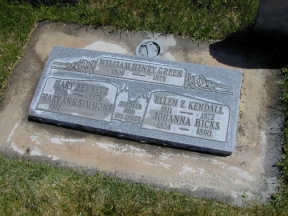
Headstone of William Green and his four wives
Pleasant Grove, Utah Cemetery
![]()
HISTORY OF
WILLIAM HENRY GREEN
Written and compiled by Melissa Green Manwill
Parleys Camp, South East Center
England
in
that period was an agricultural country, with trade centering in
a few large towns. During the 18th century, a series of
mechanical inventions led to the great advance in manufacturing.
This period was called the Industrial Revolution. This, coupled
with the rapid development of overseas markets caused a shift of
the population. Between 1770 and 1831, Liverpool multiplied its
population five times. Manchester rose from nine million to
eighteen million. There was no legislation to control the vast
industrial development, as there was great suffering on the part
of the exploited working classes. Among those drinking of the
bitter as well as the refreshing cup of experience was the
family of William Henry Green.
In
the fall of 1829 he married the girl of his choice, Mary
Bennett. She was born a short distance away, in an inland town,
bounded on the north by Chestershire, and a small portion of the
Welsh county of Flint. Although several years his senior, Mary
proved to be a very capable and efficient helpmate.
A
small cottage of rough lumber, located in the market town of Claverly, in the All Saints parish,
was the first abode shared by William and Mary. William, a
"common laborer", earned his daily bread by the sweat of his
brow. Four children were born to this union. They were: Samuel,
born 28 Oct 1831 at Claverly; John, who is my grandfather, born
27 October 1834; Mary, born 19 February 1837; and Hannah, born
15 March 1841.
The
Green
family started shifting around to find employment, first in
Gloucestershire and Staffordshire. At an early age Samuel and
John shifted for themselves, seeking employment. later they
joined their father, who had taken up residence in Kensworth, Hertfordshire. It was
here that the family became interested in Mormonism. They joined
the Bedford Conference, after being baptized January 11, 1850.
They became devout members of the Studham Branch. After joining
the Church, life changed for the Green family. They had accepted
the new religion from the depths of their hearts and although
ridiculed by many, they were willing to make all sacrifices
necessary for the Gospel's sake. Their greatest desire was to
gather with the Saints to Zion.
It
was shortly after Christmas in the year 1852, when William Green
and family bade farewell to their old friends and relatives,
clicked the key in the door of the little greystone cottage
which they called home for the last time. This home was located
on McRowan St. in Worcester. Mary's heart rejoiced as she
thought of a new home and friends they would join, and mingle
with in the land of the Rockies; little did she dream of the
sacrifices and hardships they would experience in the days to
follow.
Arriving
at
Liverpool, William deposited 6,000 shillings to pay for their
transportation to America. After making all arrangements, they
were told that the sea was rough and dangerous and that no ships
would sail before the middle of January. The only thing William
could do was rent a small place and wait. Here Mary glimpsed
signs of difficulties.
The
Green
family was assigned to sail on the Ellen Maria, but the
Captain informed them that only Samuel would be able to go.
Having no desire to sail alone, Samuel sold his ticket to
another passenger and he remained to travel with his dear
family. In the emigration records of Liverpool is found the
following: Wm. Green, age 43, served in the British Army in
Company E, Address McRowan St. Watford, Worcester; Mary, his
wife, age 57; Samuel, son, age 21; John son, age 18; Mary,
daughter, age 14; Hannah, daughter, age 11.
Sunday,
January
23, after a prayerful and instructive meeting, William H. Green
and family made ready again to set sail on the ship Golconda,
but again disappointment was experienced when they were
transferred to the ship Elvira Owen. This vessel docked
in Liverpool Harbor February 2, 1853, and finally set sail for
New Orleans, February 12.
Under
direction
of Joseph W. Young, who presided over the Preston Conference, a
company of 345 Saints left Liverpool. Imagine the emotions they
felt as they bid farewell to their native homeland, perhaps to
never see it again, and sail out into a new country, but their
faith was so great that the Lord would protect them that they
never wavered.
On
March 23, 1853 after a speedy voyage, lasting only 36 days, the
ship arrived at the bar at the mouth of the Mississippi. The
trip across the vast span of water was far from being pleasant.
The Green family, along with others, were frightened and seasick
from the rocking of the ship and the violent waves dashing over
the deck. Food and fresh water must be taken along. One pint of
drinking water a day was allowed each person. All cooking was
done in a small room on deck, then the food had to be carried
down the ship ladder to the family members below. There were
daily prayers for guidance and safety. Mary, the daughter, often
mingled her beautiful voice with the other Saints in singing the
songs of Zion. Thus amid laughter and tears the long hours were
spent at sea.
Waiting
to
welcome the Saints at the bar was Brother John Brown, the Church
agent in charge of all Saints on their way to Utah. After being
detained for several days, the vessel was towed up the River,
landing in New Orleans the 31st day of March. Proceeding up the
river they arrived at Keokuk on April 13, being two days short
of being two months since leaving Liverpool. This was considered
an extraordinarily rapid journey.
While
journeying,
Brother John Brown told the Green family about the beautiful
Utah Valley, with its groves of cottonwood trees and sparkling
streams of fresh water. "It would be an ideal spot to call
home", said Elder Brown.
While
making
necessary preparations for the long trek across the Plains, the
Green family pitched their tents at Montrose, Iowa. When
everything was in readiness, they started the trek into the
wilderness. The morning they left, the sun was shining full
strength overhead. This was the morning of July 11, 1853. Some
of the Company came under the provision of the Ten Pound
Company, and some by the Perpetual Emigration Fund. The Greens
came by the Ten Pound Company.
The
Company
had 17 horses, 2 mules, 216 oxen, 83 cows, 12 heifers, 52
wagons, and one carriage. They came in the Cyrus H. Wheelock
Company. All the Saints were anxious and eager to reach their
destination. They were overjoyed at being on their 1500 mile
journey. Both adults and children walked almost the entire
distance. Occasionally the younger ones were allowed to rode on
the back of an oxen, after their feet had become blistered and
sore. The hot sand burned their feet, and the cactus thorns
often penetrated their feet. The way was long and hard. Patience
and endurance coupled with faith and trust in their Heavenly
Father marked well the trail, as they slowly plodded along.
Summer heat faded into chilly autumn breezes.
It
was a joyful day when they reached the mountains. and looked
down into the Salt Lake Valley. Their arrival was October 16,
1853.
Captain
Wheelock
says, "I am happy to state that the Camp in general, both people
and oxen are in a prosperous condition, considering the
privations they have been compelled to submit to in crossing
over many barren districts." They traveled in two companies, the
first under Captain Pixton's Ten Pound, and Captain Whitworth's
Independent Company.
After
a
short rest in Salt Lake, the family decided to go south into
Pleasant Grove, Utah. President Brigham Young encouraged them to
help settle the community. Traveling with their covered wagons,
yoke of oxen, and their meager belonging, they entered Pleasant
Grove hoping to find rest and peace of mind, and a permanent
home.
The
Fort
had just been completed. So it was inside the Fort that the
family found their home in the land of Zion. What a happy
feeling it was to know that at last they had reached their
destination. They lived in their covered wagon until a one-room
house could be built inside the Fort Square. The children liked
to get water from the unique water system which was piped from
the mountain springs to the Fort. A covering made to keep the
water clean was lifted up and water dipped out with a bucket,
then the wooden covering was replaced. Anyone caught tampering
with the water was fined.
The
year
1855 proved a sad one for the Saints, who were so bravely
struggling for existence. Mid-summer promised a bounteous
harvest, but with the return of the crickets, coming in a cloud
and eating every blade of green grass there was, discouragement
ran high. By the time these pests were destroyed, the crops were
also destroyed. During these trying times the mother and
children went into the foothills to dig sego, thistle and
red-root. After cooking them, they tasted delicious to the
starving settlers. All shared from their scanty storehouse, one
with another. With prayerful hearts they survived an extra hard
winter.
The
Green
family was a large one-room log cabin built two blocks east of
the center of present Pleasant Grove city. A short time later,
William replaced this log cabin with a two-story soft rock home.
Farmers by vocation, the Green family were progressive and
industrious people, extremely prompt and exact in all their
dealings with their fellow man. Due to the severe winters, all
clothing must be made warm and durable, so knitting needles were
seldom idle. By the dim candle light Mary knit, sewed, darned,
tore carpet rags, and made quilt blocks. Old stockings and
high-necked sweaters were unraveled and reknit into warm
mittens, stockings, and gloves.
In
the late summer, after the grain had been harvested, Mary and
the children gleaned for the heads that had been missed. These
kernels of wheat were threshed out by tromping on the sacks.
They continued using the old coffee mill to grind the wheat into
flour. William was a strong believer in the old saying, "Make
hay while the sun shines", for in the spring he was up at 5 a.m.
In the winter, six o'clock found him up working around his home.
As
the settlement of Pleasant Grove grew, William became the town
herdsman. He was responsible for taking the cattle safely to and
from pasture each morning and night. There were marauding
Indians and would steal a calf or cow when they could.
William
Henry
died December 5, 1878, at the age of seventy. He was buried in
Pleasant Grove. The Deseret News didn't carry an account of his
death, as it was also the death date of Apostle Orson Hyde. The
paper gave three full columns about his funeral and his sermons,
so there wasn't any room for any other death notices.
William
Henry
was of a very jovial nature. He was of a medium build, with thin
dark hair. He had a capacity for courageous faith. It is to the
credit of the Green family that they met the test. He was a
stalwart colonizer in the Pleasant Grove settlement. He helped
the town grow toward a better life for its people. He had a span
of mules, and one night he went into them without first talking
to them. They became frightened and kicked him. He died from the
effects of this accident.
This
history
was written and compiled by a great-granddaughter: Melissa
Green Manwill, 2279 Oneida St., Salt Lake City, Utah; Parleys
Camp, South East Center; April 22, 1971. It is on file at the
Daughters of Utah Pioneers Library, Salt Lake City.
FAMILY GROUP RECORD OF
WILLIAM HENRY GREEN
AND MARY BENNETT
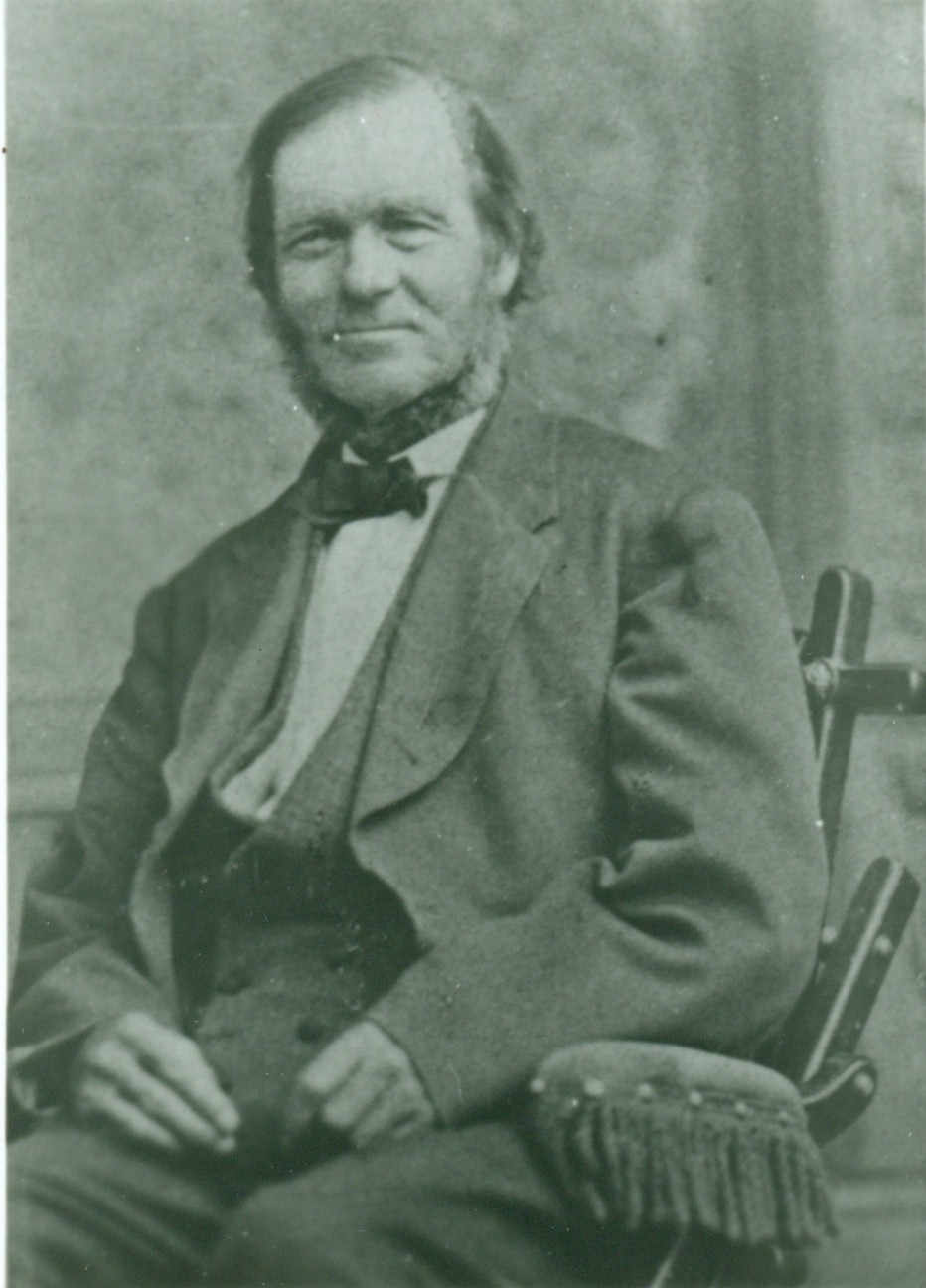
WILLIAM HENRY GREEN was born 1 January 1809 in Wolverhampton, Stafford,
England, to John Green and Sarah Meredith. He was christened 5
February 1809 in Penn, Stafford,
England. William Henry married (1) MARY BENNETT (THOMASON) 20
July 1830 in Kingswinford, Staffordshire, (2) Mary Ann Simmons
Harris 1 October 1864 in Salt Lake City, (3) Ellen Edmondson
Kendall in 1866 in Salt Lake City, and (4) Joanna Richards Hicks
9 November 1874 in Salt Lake City. Mary Bennett was christened
22 August 1796 in St. Phillips, Birmingham, Warwickshire to
William and Elizabeth Bennett. She was raised in the area around
Bridgnorth, Shropshire. She married (1) Samuel Thomason 12 April
1819 in Kidderminster, Worcestershire, then (2) William Henry
Green. William and Mary were married just after William's mother
died, and only a few short weeks before his father died. He was
the only surviving child of his father. William and Mary
emigrated to Utah in 1853. William Henry died 5 December 1878 in
Pleasant Grove, Utah, Utah and was buried there. Mary died 9
July 1874 in Pleasant Grove and was buried there. William Henry
and Mary had the following children:
*1.
Samuel, born 28 October 1831 in Claverley,
Shropshire, England; married Pamelo Wishaw 28 August 1858 in
Salt Lake City; died 18 January 1910 in Pleasant Grove.
2.
John, 23 November 1834 in Claverley; married Sarah
Malinda Alexander 27 May 1856; died 16 November 1908 in Mona,
Juab, Utah.
3.
Mary, 19 February 1838 in Claverley; married Henson
Walker 3 July 1856 in Salt Lake City; died 4 January 1906 in
Pleasant Grove.
4.
Hannah, born 15 March 1841 in Claverley; married George
William Meyrick about 1862; died 13 June 1919 in Salina, Sevier,
Utah.
Prior to her marriage to William Henry Green, Mary was married to Samuel Thomason, and had a daughter:
1. Sarah (Thomason), christened 26 May 1822 in
Bobbington, Staffordshire; married Thomas Crowther 7 May 1849 in
Dudley, Worcestershire; died 6 March 1855 near St. Louis,
Missouri.
SOURCES: History of the William Henry Green Family; Henson Walker Family History; IGI; "History of William Henry Green" by Melissa Green Manwill; The Family of William Henry Green; Joseph B. Robinson; Ancestral File, Family History Library; St. Phillips parish register, Birmingham; Quatt parish register, FHL# 501467; Kingswinford parish register, FHL# 435779; Kidderminster parish register, FHL# 435266; National Burial Index; 1841 English census.